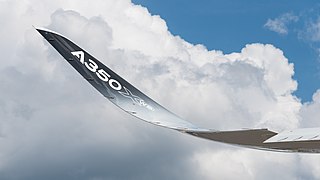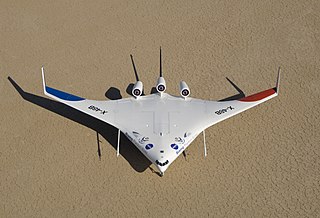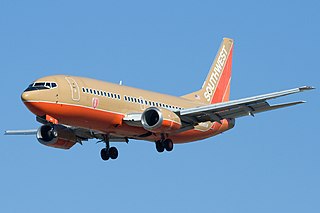
The Boeing 737 is a narrow-body aircraft produced by Boeing at its Everett and Renton factories in Washington. Developed to supplement the Boeing 727 on short and thin routes, the twinjet retains the 707 fuselage width and six abreast seating but with two underwing turbofans instead of four. Envisioned in 1964, the initial 737-100 made its first flight in April 1967 and entered service in February 1968 with Lufthansa. The lengthened 737-200 entered service in April 1968, and evolved through four generations, offering several variants for 85 to 215 passengers.

The Boeing 757 is an American narrow-body airliner designed and built by Boeing Commercial Airplanes. The then-named 7N7, a twinjet successor for the trijet 727, received its first orders in August 1978. The prototype completed its maiden flight on February 19, 1982 and it was FAA certified on December 21, 1982. Eastern Air Lines placed the original 757-200 in commercial service on January 1, 1983. A package freighter (PF) variant entered service in September 1987 and a combi model in September 1988. The stretched 757-300 was launched in September 1996 and began service in March 1999. After 1,050 had been built for 54 customers, production ended in October 2004, while Boeing offered the largest 737 NG variants as a successor.

Wingtip devices are intended to improve the efficiency of fixed-wing aircraft by reducing drag. Although there are several types of wing tip devices which function in different manners, their intended effect is always to reduce an aircraft's drag. Wingtip devices can also improve aircraft handling characteristics and enhance safety for following aircraft. Such devices increase the effective aspect ratio of a wing without greatly increasing the wingspan. Extending the span would lower lift-induced drag, but would increase parasitic drag and would require boosting the strength and weight of the wing. At some point, there is no net benefit from further increased span. There may also be operational considerations that limit the allowable wingspan.
Luxair, legally Luxair S.A., Société Luxembourgeoise de Navigation Aérienne, is the flag carrier of Luxembourg with its headquarters and hub at Luxembourg Airport. It operates scheduled services to destinations in Europe, North Africa, the Mediterranean and Middle East with additional charter and seasonal services. It is Luxembourg's only passenger-carrying airline offering regular, non-charter service.
Air Algérie SpA is the flag carrier of Algeria, with its head office in the Immeuble El-Djazair in Algiers. With flights operating from Houari Boumedienne Airport, Air Algérie operates scheduled international services to 39 destinations in 28 countries in Europe, North America, Africa, Asia, and the Middle East, as well as domestic services to 32 airports. As of December 2013, Air Algérie was 100% owned by the Government of Algeria.

The Shuttle Carrier Aircraft (SCA) are two extensively modified Boeing 747 airliners that NASA used to transport Space Shuttle orbiters. One (N905NA) is a 747-100 model, while the other (N911NA) is a short range 747-100SR.

The McDonnell DouglasX-36Tailless Fighter Agility Research Aircraft was an American stealthy subscale prototype jet designed to fly without the traditional empennage found on most aircraft. This configuration was designed to reduce weight, drag and radar cross section, and increase range, maneuverability and survivability.

The Bell XV-15 is an American tiltrotor VTOL aircraft. It was the second successful experimental tiltrotor aircraft and the first to demonstrate the concept's high speed performance relative to conventional helicopters.

The Boeing YC-14 is a twinjet short take-off and landing (STOL) tactical military transport aircraft. It was Boeing's entrant into the United States Air Force's Advanced Medium STOL Transport (AMST) competition, which aimed to replace the Lockheed C-130 Hercules as the USAF's standard STOL tactical transport. Although both the YC-14 and the competing McDonnell Douglas YC-15 were successful, neither aircraft entered production. The AMST project was ended in 1979 and replaced by the C-X program.

The Boeing X-48 is an American experimental unmanned aerial vehicle (UAV) built to investigate the characteristics of blended wing body (BWB) aircraft. Boeing designed the X-48 and two examples were built by Cranfield Aerospace in the UK. Boeing began flight testing the X-48B version for NASA in 2007. The X-48B was later modified into the X-48C version, which was flight tested from August 2012 to April 2013. Boeing and NASA plan to develop a larger BWB demonstrator.
Sriwijaya Air is an Indonesian airline headquartered and based at Soekarno–Hatta International Airport in Tangerang, Banten. It began its operations on 10 November 2003, and flies scheduled and chartered services on domestic routes within Indonesia as well as international routes to neighbouring countries. The airline's slogan is Your Flying Partner.

A blended wing body (BWB), also known as blended body, hybrid wing body (HWB) or a lifting aerofoil fuselage, is a fixed-wing aircraft having no clear dividing line between the wings and the main body of the craft. The aircraft has distinct wing and body structures, which are smoothly blended together with no clear dividing line. This contrasts with a flying wing, which has no distinct fuselage, and a lifting body, which has no distinct wings. A BWB design may or may not be tailless.

The Shuttle Training Aircraft (STA) is a former NASA training vehicle that duplicated the Space Shuttle's approach profile and handling qualities, allowing pilots to simulate Shuttle landings under controlled conditions before attempting the task on board the orbiter. The STA was also flown to assess weather conditions just prior to Space Shuttle launches and landings.

The Boeing 737 Classic is a series of narrow-body airliners produced by Boeing Commercial Airplanes, the second generation of the Boeing 737 series of aircraft. Development began in 1979 and the first variant, the 737-300, first flew in February 1984 and entered service that December. The stretched 737-400 first flew in February 1988 and entered service later that year. The shortest variant, the 737-500, first flew in June 1989 and entered service in 1990.

The Boeing 737 Next Generation, commonly abbreviated as 737NG, or 737 Next Gen, is a narrow-body aircraft powered by two jet engines and produced by Boeing Commercial Airplanes. Launched in 1993 as the third generation derivative of the Boeing 737, it has been produced since 1997 and is an upgrade of the 737 Classic (−300/-400/-500) series.
In aeronautics, loss of control (LOC) is the unintended departure of an aircraft from controlled flight and is a significant factor in several aviation accidents worldwide. In 2015 it was the leading cause of general aviation accidents. Loss of control may be the result of mechanical failure, external disturbances, aircraft upset conditions, or inappropriate crew actions or responses.
The ecoDemonstrator Program is a Boeing flight test research program, which has used a series of specially modified aircraft to develop and test aviation technologies designed to improve fuel economy and reduce the noise and ecological footprint of airliners.
The Boeing X-66 is an experimental airliner under development by Boeing. It is part of the X-plane series, and has been developed in collaboration with NASA and its Sustainable Flight Demonstrator program. It will use extra-long, thin wings stabilized by diagonal struts, which is known as a Transonic Truss-Braced Wing concept. The aircraft configuration is based on research studies referred to as "Subsonic Ultra-Green Aircraft Reach (SUGAR)" which extensively studied truss-bracing and hybrid electric technologies.













